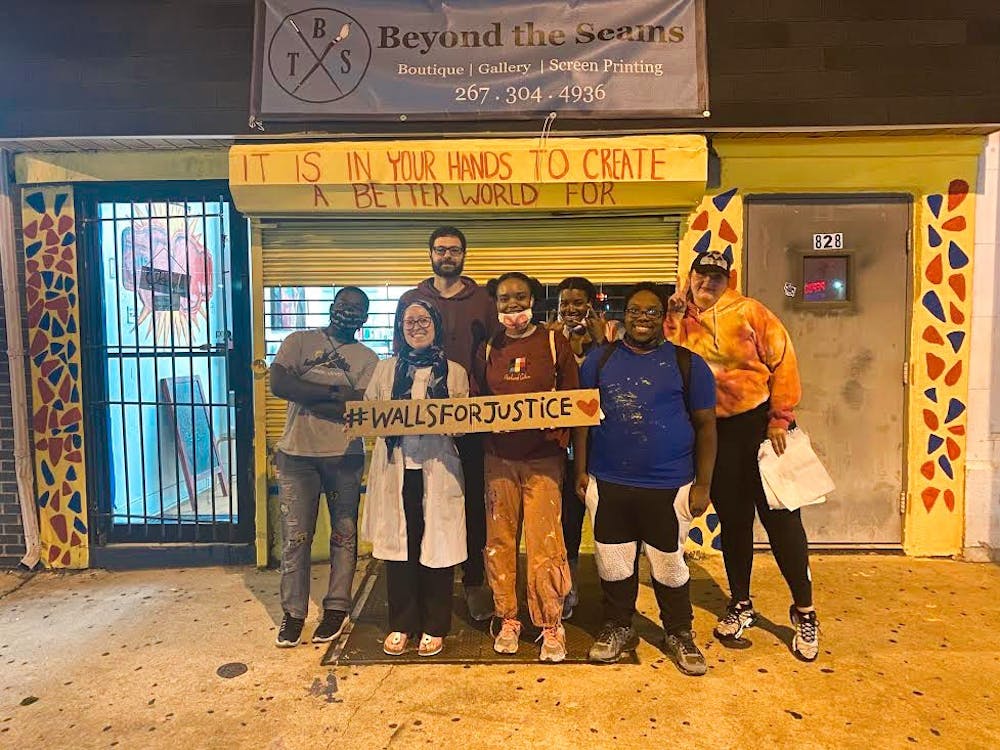As protests supporting the Black Lives Matter movement began to gain traction a couple of weeks ago, business owners grew anxious about the repercussions that civil unrest could have on their properties. In response to this, many owners boarded up their storefronts in an attempt to prevent any sort of destruction.
Philadelphia-based artist, Samuel Rodriguez, saw the effect that this had on the community, recognizing that, even if it wasn’t intended, boarding up the stores sent a negative message. Samuel says that boarding up the storefronts “speaks to where [business owners] are in the situation, they’re scared, they want to protect what’s theirs, and they kind of don’t want anything to do with anything except for their business and their livelihood.”
This is why Walls For Justice was born, an organization that aims to unite members of the Philadelphia community through the painting of murals to beautify the boarded storefronts. These murals have the objective of transforming the message they are giving by turning the boards into a canvas supporting the BLM movement.
Samuel knew he wanted to start an art project when the pandemic started, as he was feeling particularly artistic during quarantine. However, it wasn’t until he witnessed the first couple of protests in New York City that his idea started to gain clarity.
“There was a lot of crazy stuff happening and I had an urge to do something about it. I didn’t know exactly what I wanted to do, but I knew that I wanted to be involved,” he says.
Samuel remembers seeing the protests evolved, and even though he supported the movement, he was nervous about protesting with large crowds due to COVID-19. Once he returned to Philly, he knew he wanted to use art as a way to express his support, which led him to post a call for artists on his social media sites.
“Something just sparked me to put a call to artists, to my friends on my Instagram and see who wanted to come with me and paint. I knew I wanted to paint positive messages to support the Black Lives Matter movement, and the first couple hours two friends responded to me,” he says.
Soon after, he went with one of his friends to practice painting the solidarity fist in abandoned buildings. He recalls how people passed by and cheered them on, which made him want to create something bigger. However, the group got in trouble for painting on abandoned buildings, which is when the idea of Walls For Justice came to be.
“So, I painted a few times and actually got in trouble for painting on someone’s property...I was almost ready to quit and go home, but Alexandra was there, and she said, ‘Come on, if we ask permission, we could probably do it for free.’ And I said, ‘Hey you’re absolutely right, why don’t we go around and ask store owners to see if they’ll let us paint?’” Samuel says.
At first, a lot of the businesses they approached said no, but the team decided to keep trying. Once one business owner said yes and they painted their first project, more and more storefronts became available to the group. Samuel recalls how the project began to grow. As they painted their first mural, people would approach them to take pictures of their work, and the name Walls For Justice was officially created.
“People would come up to us and take pictures, and I remember at the moment Alexandra was with us and I said, ‘Hey, we need a hashtag so we can at least follow the pictures that people are taking of us.’” Samuel says. “And at the moment I said Walls For Justice, Alexandra fact-checked it, made sure no one else was using it, and it was clean, not one single person had used the hashtag, and at that very moment we created something and the timing was perfect.”
The first couple of days, Samuel recalls how they used his own painting supplies. But as more businesses wanted to join, and more volunteers wanted to participate (following social distancing protocols), he decided to open a GoFundMe for donations to keep the momentum going. Even as stores begin to open up and remove their boards, Walls For Justice is an organization Samuel wants to continue with.
“We’re going to continue; we’re going to go from panels to walls. We’ve been talking to some business owners who will continue putting up panels just so we can come and put artwork on them, We already have contact with people wanting us to paint the side of their houses,” Samuel says. “What we’re going to do with the panels is we’re going to collect them and start an art gallery in the future, or just an exhibition where we can continue the conversation because these art pieces will be like time capsules that can prolong the conversation of what’s happening around us.”
As Walls For Justice grows, it reinforces the idea of creating unity within the community to fight for change. Even though there are different ways to express support, Samuel found a space in the art world. He hopes to continue influencing people and unifying the community through the painting of murals.
“I found out that art can be the change. There was no tension in what we were doing. No one told us to stop, everyone just encouraged us, everyone loved it,” he says. “The togetherness is what we need, and that’s what is highlighted in everything. This peaceful protest, the community coming together to restore, to clean up, that’s the beauty, the unity.”






